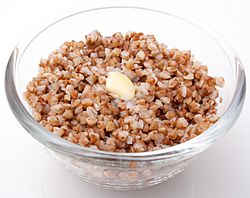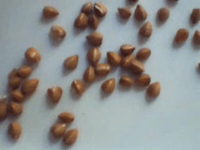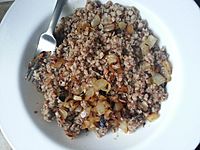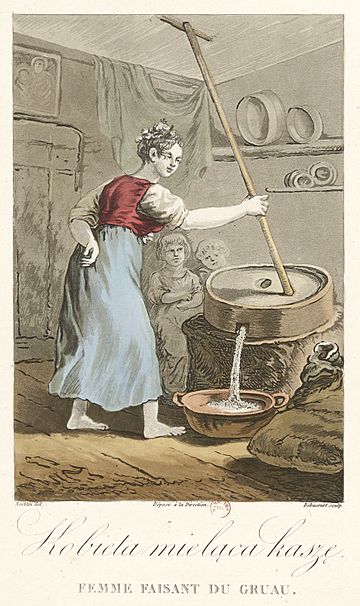Kasha facts for kids

Buckwheat kasha
|
|
| Type | Porridge |
|---|---|
| Main ingredients | Cereal (buckwheat, wheat, barley, oats, millet or rye) |
Kasha is a type of cooked grain, much like a porridge. In English, when people say "kasha," they usually mean a dish made from buckwheat. Buckwheat is a "pseudocereal," which means it's used like a grain but isn't actually a grass.
However, in many countries in East-Central and Eastern Europe, "kasha" can mean any kind of cooked grain. It's often boiled in water or milk. Sometimes, the word "kasha" can also refer to the raw grains themselves, before they are cooked.
This wider meaning of kasha is common in countries like Belarus, the Czech Republic, Lithuania, Poland, Romania, Moldova, Russia, Slovakia, Kazakhstan, and Ukraine. In these places, kasha can be made from wheat, barley, oats, millet, and rye, not just buckwheat. Kasha has been a very important food for Slavic people for over a thousand years.
The English use of the word "kasha" likely came from Jewish immigrants. They used the word kashi (קאַשי), which means "porridges."
Contents
Kasha in Different Cultures
Ashkenazi Jewish Culture
Kasha is a popular comfort food for Ashkenazi Jews. It is often served with onions and a brown gravy. Sometimes, it's mixed with bow tie pasta in a dish called kasha varnishkes. Kasha is also a common filling for knishes, which are baked or fried dough pockets. You might even find it in matzah-ball soup.
Kasha in Czechia
In the Czech Republic, the word for kasha is kaše. This word has a broader meaning. It can refer to many kinds of mashed foods. For example, mashed potato is called bramborová kaše, and pease pudding is hrachová kaše.
Kasha in Poland
In Poland, cooked buckwheat groats are called kasza gryczana. But just like in other Eastern European countries, Kasza can mean many different types of groats. These include millet (kasza jaglana), barley (kasza jęczmienna), and oats (kasza owsiana). Even porridge made from farina (kasza manna) is a type of kasza. Bulgur is also sometimes called kasza bulgur.
A type of blood sausage in Poland is called kaszanka. It is made with buckwheat, barley, or rice kasha. On average, people in Poland eat about 1.56 kilograms (about 3.4 pounds) of groats each year.
Kasha in Russia
Russia eats the most buckwheat per person in the world, about 15 kilograms (33 pounds) each year. Ukraine is second, with 12 kilograms (26 pounds) per year. Buckwheat makes up about 20% of all cereals eaten in Russia.
In Russian, buckwheat is often called гречка (grechka). The cooked dish is called гречневая каша (grechnevaya kasha).
The most popular kasha in Russia is crumbly cooked buckwheat, often served with butter. People eat buckwheat kasha at any time of day. It can be a main dish or a side dish. Other popular kasha dishes are made with millet, semolina (манная каша), and oatmeal. These are often cooked with milk and sugar, making them a common breakfast, especially for children.
Kasha is considered one of Russia's national dishes, along with shchi (cabbage soup). There's a famous Russian saying: "щи да каша – пища наша" (shchi da kasha – pishcha nasha). This means "shchi and kasha are our food." It suggests that these two simple meals are enough for life.
Another Russian saying about kasha is: "кашу маслом не испортишь." This translates to "you'll never spoil kasha with a lot of butter." It means that adding more butter only makes kasha better!
See also
 In Spanish: Kasha para niños
In Spanish: Kasha para niños





